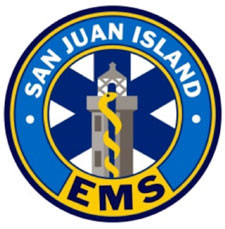SJIEMS in 2019
Posted December 21, 2019 at 8:48 am by Tim Dustrude
 The following press release was submitted by SJI EMS…
The following press release was submitted by SJI EMS…
As we close out 2019, we thought we would spend some time discussing some of the highlights of the year for San Juan Island Emergency Medical Services (SJI EMS).
Expansion of Paramedicine Program
One of the important programs that SJI EMS has expanded is our pioneering community paramedicine program. It’s a new program nationally, and still a pilot program in Washington. The program uses staff EMTs to provide non-emergency care for at-risk patients and helps them access social and partner services as needed.
Outreach Director Lainey Volk said, “We’ve been early adopters because we can see that it fills a crucial gap in care. For instance, somebody who has dementia – it’s not considered a mental health issue in the traditional way, therefore, mental health resources don’t apply. We help fill that gap.” Volk further added, “It’s really rewarding to see how people’s lives change for the better despite really difficult situations where they would be much worse off without the help.”
These at-home visits monitor medication usage, make safety recommendations, check for falling hazards, and otherwise reduce the need for 9-1-1 services — which is good for providers, patients, and the public. Please direct inquiries to Lainey Volk, (360) 378-5152 ext. 3.
The goal is always prevention, and Director Volk also oversees CPR classes and other programs to that end. This contributes towards San Juan County’s cardiac save rates of twice the state average, and almost four times the national average (according to WA Cares).
Move to 24-7 EMT Staffing at Station
In late 2018, the Board governing SJI EMS voted to allocate funding for in-house staffing of the EMS station twenty-four hours a day, every day of the year, starting January 1, 2019.
Chute times, meaning the time it takes an EMT to get the ambulance and leave the station, have improved significantly since then. The first half of the year showed an improvement of 1:36 minutes over the same period in the year before.
Not surprisingly, Friday Harbor receives the quickest response because it’s close to the station. Average response time, or “ambulance arrives at my door” time for November 2019 was 06:48 with over 80% of calls under 10:00 minutes — a trend through 2019. Mid-island, response times average 11-12 minutes but are still very strong. Calls often have volunteer EMTs who show up and start providing aid before the ambulance even arrives.
Interim Chief Karl Kuetzing said, “Not only are response times better, but now a career EMT comes with every ambulance. Our ability to handle simultaneous calls is improved. Overall our service is more comprehensive.”
We want to remind the public to always call 9-1-1 when having a medical emergency. Patients often have complicating issues en route to the hospital which can be risky in a private vehicle. Additionally, patients can be treated on scene as needed and some form of help often arrives within minutes. Remember that for District residents and landowners, SJI EMS does not bill coinsurance. There’s really no reason not to call 9-1-1!
Financial Stability
Nationwide, EMS calls are increasing, straining the resources of emergency response at all levels. In many areas of the country this is compounded by rural hospital closures. We are so fortunate that we have strong partners in San Juan County.
SJI EMS handled about 1100 calls in 2018, a number that was already met by the end of November 2019. We expect to exceed that number by as much as 5-10%. 24-7 station staffing and the expansion of the community paramedicine program helps ensure our ability to respond in the face of these trends.
Strong finances allow us to provide these expanded programs. We are fortunate to have received funding from the Affordable Communities of Health (ACH) and a joint Federal/State program called the GEMT program. Medicaid patients are a financial loss for many providers, and the GEMT program helps reduce that strain.
All of this has resulted in a best-case scenario for taxpayers: expenses below expected, and revenue above expected – and none of the extra revenue due to an increase in property tax rates. Much of the ancillary income (ACH, GEMT) will be transferred into a fund for capital investments (ambulances, AEDs, etc.).
As EMS anticipates being moved out from underneath San Juan County Public Hospital District No. 1 towards a planned integration with San Juan Island Fire and Rescue between 2020 and 2022, the strong financial performance and superb service is expected to continue and taxpayers will enjoy further improvements and efficiencies at all levels.
You can support the San Juan Update by doing business with our loyal advertisers, and by making a one-time contribution or a recurring donation.
Categories: Health & Wellness, Safety










No comments yet. Be the first!
By submitting a comment you grant the San Juan Update a perpetual license to reproduce your words and name/web site in attribution. Inappropriate, irrelevant and contentious comments may not be published at an admin's discretion. Your email is used for verification purposes only, it will never be shared.